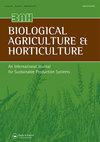荧光激发光谱法检测小麦和豆类样品的低剂量x射线辐照
IF 1.6
4区 农林科学
Q3 AGRONOMY
引用次数: 1
摘要
电离辐射用于保存食品和提高食品安全,但不允许用于有机产品,除非使用低剂量(小于500 mGy)用于检测目的(例如异物的存在)。通过在10 Gy或以上辐照的产品中检测2-烷基环丁酮(2-ACBs),可以对辐照进行分析验证。低剂量辐射对食品的影响尚未进行调查,但在血液中,即使辐照强度为1毫戈瑞也可检测到。本初步研究的目的是确定荧光激发光谱(FES),一种对产品的微小变化非常敏感的方法,是否可以区分暴露在不同强度x射线下的豆类种子和小麦颗粒。大豆和小麦谷物样品分别接受500毫戈瑞(检测剂量限值)、50毫戈瑞(极低剂量)和0毫戈瑞(对照)的辐照。用FES测量延迟发光,在FES参数Mw1-r中发现辐照对小麦样品的影响,辐照500 mGy时最高,50 mGy时居中,0 mGy时最低(对照)(p < 0.001)。在大豆种子中,这种效应不太明显,只有在500 mGy辐照下与对照相比,Mw1-r参数才有显著差异(p < 0.05)。两种种子区分辐照强度的参数相同,变化方式也相同。因此,在低剂量辐照强度下观察到系统剂量特异性效应。本文章由计算机程序翻译,如有差异,请以英文原文为准。
Low-dose X-ray irradiation of wheat and bean samples detectable by fluorescence excitation spectroscopy (FES)
ABSTRACT Ionizing irradiation is used to preserve foodstuffs and improve food safety, but it is not permitted for organic products, with the exception for using low doses (less than 500 mGy) for detection purposes (e.g. the presence of foreign objects). Analytical verification of irradiation is possible by detection of 2-alkylcyclobutanones (2-ACBs) in products irradiated with 10 Gy or more. Effects of lower doses of radiation on foodstuffs have not been investigated yet, but in blood, irradiation is detectable even at intensities of 1 mGy. The aim of this preliminary study was to determine whether fluorescence excitation spectroscopy (FES), a method which is very sensitive to small changes in the product, could differentiate between bean seeds and wheat grains exposed to X-rays of different intensities. The bean and wheat grain samples were irradiated at 500 mGy (dose limit value for detection purposes), 50 mGy (very low dose) and 0 mGy (control). Measuring the delayed luminescence by FES, effects of irradiation were found in the wheat samples in the FES-parameter Mw1-r, with the highest values for samples irradiated with 500 mGy, intermediate values for 50 mGy and lowest values for 0 mGy (control) (p < 0.001). The effects were less apparent in bean seeds, with a significant difference (p < 0.05) in the parameter Mw1-r only when comparing irradiation at 500 mGy with the control. The parameter differentiating the irradiation intensities was the same for both seeds and changed in the same way. Thus, systematic dose-specific effects were observed for low-dose irradiation intensities.
求助全文
通过发布文献求助,成功后即可免费获取论文全文。
去求助
来源期刊
CiteScore
3.30
自引率
6.70%
发文量
18
审稿时长
>36 weeks
期刊介绍:
Biological Agriculture & Horticulture aims to act as the central focus for a wide range of studies into alternative systems of husbandry, and particularly the biological or organic approach to food production. The Journal publishes work of a sound scientific or economic nature related to any aspect of biological husbandry in agriculture, horticulture and forestry in both temperate and tropical conditions, including energy and water utilization, and environmental impact.

 求助内容:
求助内容: 应助结果提醒方式:
应助结果提醒方式:


